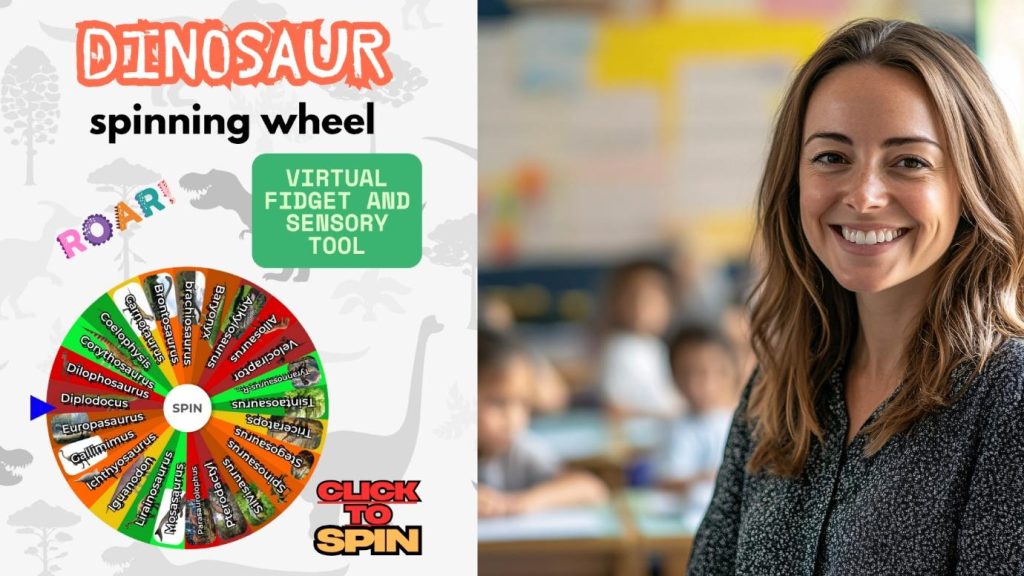
Interactive spinner wheels with hidden activities and AI-assisted personalization are helping neurodiverse students stay focused, calm, and engaged through sensory-friendly, structured, and inclusive learning experiences.
A Smarter Spin on Classroom Engagement
For students with autism, ADHD, or sensory processing differences, focus can depend on how information is presented. Traditional classroom methods can overwhelm or disengage — but interactive digital tools are helping to change that story.
A spinner wheel — simple, visual, and rhythmic — brings structure, motion, and anticipation into learning. Its familiar spin-and-reveal design offers a predictable sensory rhythm that helps neurodiverse students stay grounded.
When combined with today’s AI-powered educational assistants, this dynamic tool becomes even more powerful. The spinner wheel drives engagement and participation, while AI helps teachers personalize and extend those learning experiences — creating a harmonious balance between structure and support.
Sensory Engagement Through Structure and Surprise
Research shows that predictable, rhythmic movement supports attention and emotional regulation in neurodiverse learners (Ashburner, Ziviani & Rodger, 2008; Dunn, 2017). A spinning wheel captures this rhythm beautifully: it moves, stops, and reveals something new — providing the brain with both predictability and novelty.
A free wheel of names teacher resource tool online, such as Random Wheel Spin, lets educators create custom quiz wheels and add hidden activities or actions behind each segment. This simple feature transforms the wheel from a visual aid into an interactive teaching experience.
Teachers might spin to reveal:
- A quick problem-solving task
- A discussion prompt
- A sensory break instruction
- A “challenge round” for gamified revision
The wheel’s “hidden actions” keep students curious without overwhelming them. Even more, it can speak results aloud, giving auditory reinforcement for learners who process sound more effectively than text — an inclusive design that aligns with multi-sensory teaching principles (Fletcher-Watson et al., 2019).
AI as the Quiet Teaching Partner
The spinner wheel doesn’t need AI to work — it already creates a meaningful sensory and cognitive bridge for learners. But when AI assists alongside, it helps teachers fine-tune how and when to use the wheel most effectively.
Here’s how AI complements, rather than replaces, the spinner wheel’s role:
- Smart Personalization: AI tools can analyze student progress or quiz results and recommend which hidden activities to include in future spins — helping tailor content to each learner’s level.
- Timing Insights: AI-based learning analytics can identify optimal moments for a wheel spin — for example, when attention typically dips — ensuring the tool is used at the right time, not just randomly.
- Voice and Accessibility Integration: AI-powered voice synthesis can enhance the spinner’s read-aloud feature with natural, expressive speech in multiple languages — improving inclusion for multilingual or visually impaired learners.
- Content Generation: Generative AI tools can help teachers quickly design creative “hidden actions” or quiz questions — keeping the wheel fresh and engaging without extra workload.
In this way, AI amplifies the wheel’s interactivity, helping teachers make data-informed decisions while preserving the fun, tactile simplicity that makes spinner wheels so effective.
Predictable Novelty: A Sensory-Safe Learning Pattern
For neurodiverse learners, predictable novelty — consistency with gentle variation — is key. The spinner wheel embodies this balance: every spin follows the same sensory rhythm, yet the outcome is new.
Studies show that short, visually guided activities can help students reset attention (Ariga & Lleras, 2011) and that repetition in sensory patterns provides comfort and control (Kapp et al., 2020). AI can observe these response patterns quietly in the background, learning when students benefit most from a spin or suggesting when to pause for reflection.
Together, these systems encourage focus without pressure, turning brief digital moments into opportunities for emotional and cognitive regulation.
Classroom Applications in Harmony
Educators are now blending spinner wheels and AI tools in inclusive, practical ways:
- 🎯 Sensory breaks: The wheel triggers short, AI-timed brain breaks for students who need predictable routines.
- 💬 Language support: The spinner’s audio output, enhanced by AI text-to-speech, supports language learners and students with reading difficulties.
- 🧠 Adaptive quizzing: AI selects which hidden questions appear next, matching challenge levels to each learner’s recent progress.
- 🎲 Equitable engagement: Spinner wheels ensure fairness in selection, while AI analytics confirm participation is balanced.
- 🧩 Differentiated instruction: Teachers can design multiple wheels for different needs — sensory, social, or academic — with AI offering gentle insights on what works best for each group.
These uses preserve what makes spinner wheels effective — simplicity, fun, and structure — while quietly enhancing their impact through intelligent, data-informed feedback.
Inclusive Design for Every Learner
What makes this approach powerful is its simplicity and empathy. The wheel offers tactile and visual engagement; AI ensures those experiences stay relevant, balanced, and accessible.
Teachers remain firmly in control — deciding what’s behind each spin, when to use it, and how it fits the lesson. AI simply assists by organizing insights and generating options.
This model of harmony — human creativity, sensory structure, and adaptive intelligence — is the future of inclusive learning design.
References
- Ashburner, J., Ziviani, J., & Rodger, S. (2008). Sensory processing and classroom emotional, behavioral, and educational outcomes. Journal of Autism and Developmental Disorders.
- Dunn, W. (2017). Sensory Profile 2: User’s Manual. Pearson.
- Ariga, A., & Lleras, A. (2011). Brief and rare mental “breaks” keep you focused. Cognition, 118(3).
- Kapp, S. K., Steward, R., Crane, L., et al. (2020). ‘People should be allowed to do what they like’: Autistic adults’ views and experiences of stimming. Autism, 24(5).
- Fletcher-Watson, S., et al. (2019). Inclusive educational technology for learners with autism. Frontiers in Education.
Author Note
This article explores how interactive spinner wheels — particularly those with hidden activities, actions, and read-aloud features — support neurodiverse learners through structure, engagement, and sensory regulation. Example tool referenced: Random Wheel Spin, a free customizable wheel of names platform that integrates easily alongside AI tools for inclusive, adaptive learning. The software’s creator has a personal connection to neurodiversity through their autistic daughter, which inspired the tool’s inclusive design focus.






